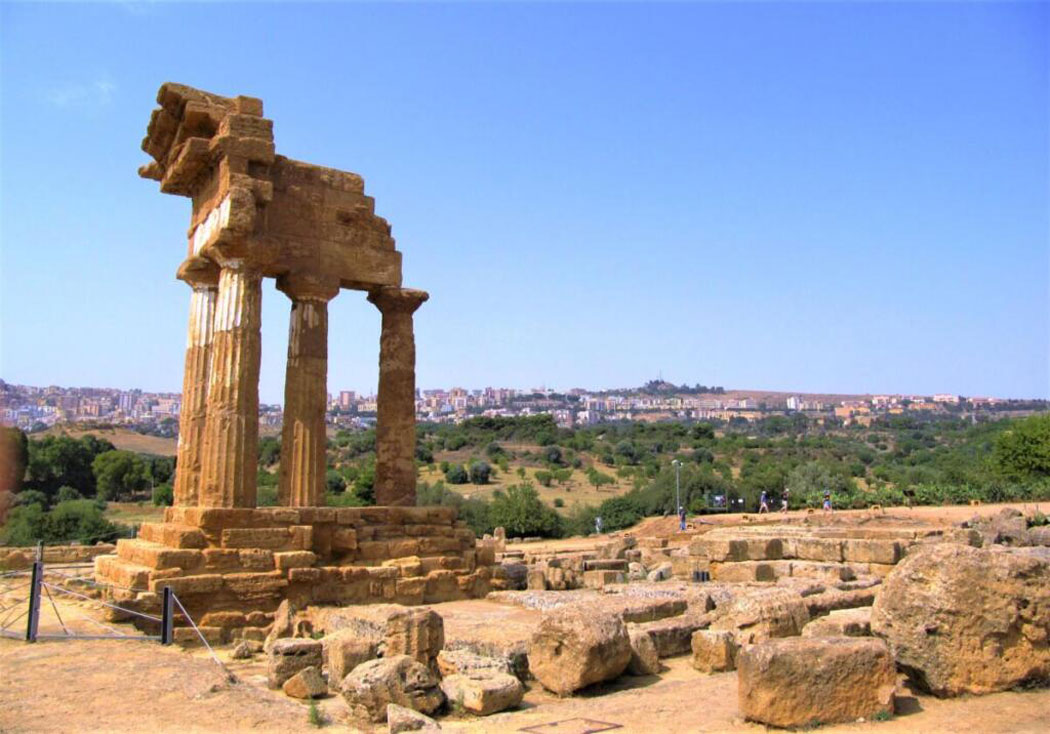

Agrigento is one of the most famous Sicilian cities in the world with the area of the Valley of the Temples included in the UNESCO World Heritage Site list. The current city is located on a hill where the ancient city of the Siculi once stood, which later became the acropolis of the Greek city.
Over the centuries it has changed its name several times: from the Greek Akragas, to the Roman Agrigentum, to the Arab name of Kerkent or Gergent, then Girgenti for the Normans until 1927 when it assumed the current name of Agrigento during the fascism period when it had recovered the ancient Roman name.
Its history begins with the foundation in 581 BC. of a settlement along the coast at the mouth of the Akragas river by Greek colonists probably from Rhodes and Crete. Its first name was Akragas and the settlement was to supply ships that traded with Africa and the Western Mediterranean.
The Sicilians already lived inland thanks to the fertility of the land (cereals, oil and wine were produced and horses were raised) and to the geographical position that favoured exchanges with the Greeks and the growth of this first settlement. The tyrant Terone expanded the borders making it an important Greek centre in Sicily, also winning patronage of the Carthaginian fleet of Amilcare.
The golden period was the the one when Empedocles was leader during which there were good relations with the powerful nearby city of Carthage.
The rivalry with Syracuse led to the decline and in 406 Agrigento was sacked by the Carthaginians of Hannibal who transformed it into their colony forcing it to not have fortifications and for it had to pay tributes.
In 339 BC the situation changed thanks to Timoleonte who, came from Syracuse, defeated the Carthaginians and helped the new foundation of Agrigento, but the rivalry with Syracuse was not long in reemerging. In the meantime, the power of Rome was growing throughout Italy, slowly conquering southern Italy and confronting the power of Carthage in the seas.
Due to its position, Sicily was strategic for the dominion of the seas, and therefore of trade and food supplies.
Agrigento was for a long time disputed between the Carthaginians and the Romans, and while it was in the Carthaginian hands, it took sides with Pyrrhus, the king of Epirus, protagonist of the first Punic war between the Carthaginians and the Romans in 264.
The Romans attacked it for the first time in 262 and plundered it making it become part of Rome, which changed its name to Agrigentum.
Rome practically conquered all of Sicily but in 213 Agrigentum was reconquered by the Carthaginians who were preparing for the Second Punic War. During this clash, in 210 BC Agrigento was reconquered by the consul Levinio who repopulated it with people from other territories.
Sicily became the grain producer of Rome and if on one hand this brought wealth, on the other it brought many Greek-speaking slaves to work in the fields. Several times they revolted and around 130 BC. Agrigento was sacked by a slave revolt.
But thanks to the richness of the soil and its position, Agrigento returned to flourish during the period of the Roman Empire.
After the fall of Rome there came the arrival of the Vandals. In 535 General Belisario conquered Sicily on behalf of the Eastern Roman Empire based in Byzantium and thus began the Byzantine period of the Island while the church of Rome divided the territory into dioceses led by bishops.
Important bishops such as San Libertino arrived in Agrigento and in 559 AD San Gregorio was born. He was a scholar of the Bible and the one who allowed the conservation of the Temple of Concordia, transforming it temporarily into a church.
From the seventh century, the raids of the Arabs led the population to move up to where the ancient acropolis once stood but from 829 Agrigento fell and was repopulated by Berbers. The name of the city became Kerkent and Agrigento returned to being a thriving cultural and commercial centre, thanks to the abundant agricultural production of sugar cane, dates, melons and mulberries. It is in this period that a new commercial port was started in the current Porto Empedocle.
The Arab cities begain to fight each other and these tensions favoured the capture of Sicily by the Normans and Agrigento fell in 1086 after a long siege. The Normans, called by the pope, brought back Catholic worship thanks to Bishop San Gerlando who today became the patron of Agrigento.
During this period, the city was declared "regal", and with this title it was entitled to a series of privileges. In the feudal period the lordship of Agrigento began thanks to the Chiaramonte, a family originally from Northern France who arrived in Sicily with the Normans.
During the period of Frederick II of Swabia, the power of the family was
confirmed and Federico Chiaramonte was knighted by the Pope who granted him the Gold Rose for his fight against the infidels.
In the Angevin period, the Chiaramonte allied with the Spaniards of Aragon during the Vespers Wars and their prestige thus increased also during the domination of the Aragonese.
With Federico Chiaramonte the city also expanded outside the original city walls and over the years the family built churches and convents with a recognizable style. Their palace was located right in front of the cathedral, which later became the
Episcopal Seminary, and their prestige reached as far as Palermo.
In 1377 the king of Sicily died and Maria of Aragon found himself as the only heir to the throne, but since the possibility of a female line was not foreseen, 4 vicars of the Kingdom of Sicily were elected, and one of these was a representative of the Chiaramonte family.
Maria was sent away so as to stop her marrying the Visconti of Milan and Martino I the old was appointed as viceroy of Sicily. Maria married Martino the younger, despite opposition from the barons because they would lose their Sicilian autonomy, gained with the Vespers, in favour of greater control from Spain.
In 1392 Andrea Chiaromonte was executed by King Martino, the dynasty of this family in Sicily ended and the lordship was entrusted to Bernardo Caprera.
The plague of 1523 accelerated the decline of Agrigento that was also affected by famine, and despair led to the growth of the phenomenon of banditry.
In 1647 the famine and the high taxes by the Spaniards led to discontent in Sicily and especially Agrigento, one of the areas where wheat was grown. Bishop Traina paid to prevent the city from losing the rights of the royal / state-owned cities. From this moment a series of bishops became the key players in the history of Agrigento.
Among the public works, the construction and expansion of the port of the Molo di Girgenti, today Porto Empedocle, should be mentioned, and in 1817 Sicily passed under the Bourbon kingdom.
The situation of unease and misery was such that the city participated in the uprisings of 1820, which then were the climate on which the Mazzinian movement grew, and in 1860 the arrival of Giuseppe Garibaldi was greeted with interest.
But the lack of response by the new wave to the promises once again gave rise to the phenomenon of banditry. The disillusionment also led to a first wave of migrants who left Agrigento and Sicily in search of luck abroad.
In 1853 the port became an autonomous municipality and shortly thereafter took the name of Porto Empedocle.
Finally in the early twentieth century a series of public works, such as the aqueduct, improved the situation of people and led to a launch of tourism.
The city was heavily bombed during the Second World War. The revival of the town included cultural tourism and the entry of the Valley of the Temples in the list of World Heritage Sites.








Follow us